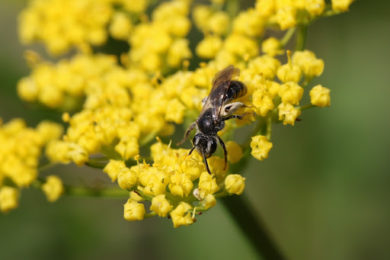
Golden Alexander Miner (Andrena vernalis/A. ziziae)
When we started the Vermont Wild Bee Survey in 2019, it seemed like every other bee we caught was a new species for the state. As it turns out that was only a bit of an exaggeration. Forty species were first recorded for Vermont in the first year of the survey (though note the graph below). In each subsequent season, new bees have still often been found, but with diminishing frequency. So far this summer only two species have been added to the state checklist, but more are likely as we work through a backlog of pictures and pinned specimens. The three stories below provide a glimpse of how we found the latest new species, and the work that remains in understanding all the bees that inhabit the Green Mountain state.
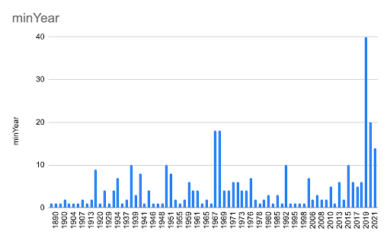
Data published to the Global Biodiversity Information Facility (GBIF.org) shows the number of new bee species found in Vermont each year. Note that more than 100 species with historical records in the state that have not yet been included in this figure.
August 17th, 2022. Spencer Hardy, the bee survey project coordinator, was looking at a marginal weather forecast and a long list of office projects. He ignored both, and made an impromptu decision to spend the morning trying to relocate and photograph a few rare bee species previously recorded in or around the Burlington Intervale. The weather held, but his target species (Svastra obliqua and Nomada electa) were nowhere to be found. After a couple hours photographing other fun bees, he started back towards the car. Along the way, one of the many patches of wild sunflowers caught his attention, buzzing with bees and other insects. A wasp looking insect with long dangly legs passed his periphery and he instinctively netted it, not even sure if it was a bee. Once in the net, he recognized it immediately as one of the project’s Most Wanted Bees. In the next 20 minutes, he was able to photograph several individuals in-situ, as well as one of its reported hosts, the Sunflower Miner (Andrena helianthi). Several species of sunflowers and the Sunflower Miner are fairly widespread throughout the state, so why this kleptoparasite has only been documented from one tiny patch of flowers remains an open question.
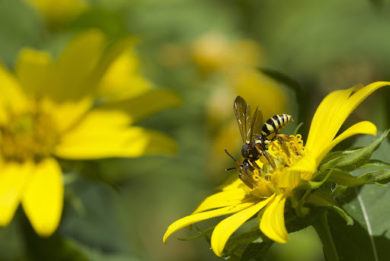
Bounded Cuckoo Nomad (Nomada vincta)
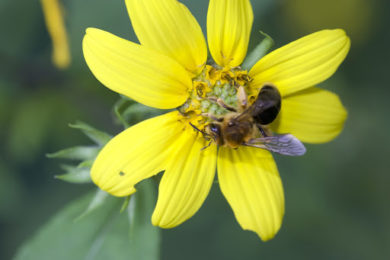
Sunflower Miner (Andrena helianthi)
July 16th, 2022. Nathaniel Sharp, a staff biologist, was wrapping up the final point of a roadside bumble bee survey west of Swanton. Once the 10-minute timer was up and all the bumblebees at a small roadside sandpit just near the bridge to Alburgh were counted, he turned his attention to a small group of miniscule bees hovering over the sand. Catching and photographing one of these bees with a macro lens, he assumed they were the common and expected species of fairy bees in the genus Perdita, but posted them to the Vermont Atlas of Life on iNaturalist to double-check. Later that week, a number of experts found the photos, and identified it as the Sandbar Willow Fairy Bee (Perdita maculigera). Not only was this species new for Vermont, it was the first record for all of New England! From the scant information available online about this bee, it appears to be a specialist on Sandbar Willow (Salix exigua), a relatively rare species in the state that blooms much later than other willow species. This bee is also likely dependent on large sand deposits for nesting, which further limits its possible distribution.

Sandbar Willow Fairy Bee (Perdita maculigera) – NRS photo
May 25th, 2022. Spencer and Nathaniel joined the refuge biologist at Silvio Conte National Wildlife Refuge for a day of bee inventorying in the Nulhegan basin near Bloomfield, VT. After finding a number of interesting bees, a rare butterfly, a boreal spider, and more mosquitos than necessary, they made one final stop in a log landing loaded with Golden Alexander. This small yellow flower hosts two very similar species of small Mining Bees (genus Andrena) that may in turn host a cleptoparasitic Nomad Bee that hasn’t been formally described yet. After just a few minutes of searching, Nathaniel picked up a tiny Nomad bee, but upon closer inspection, it was clearly not the undescribed species they were looking for. The forked mandibles mean it is in a group of Nomad Bees that is notoriously hard to identify and poorly understood. So far, It doesn’t match any of the species known from Vermont, but it may be several years (or decades) before we can confidently put a name on it.
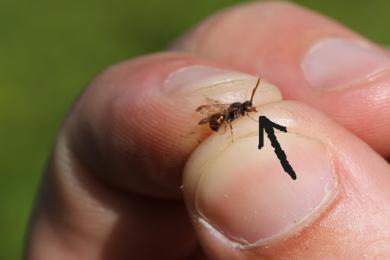
Unknown Nomad (genus Nomada). Note the mandibles mentioned above
